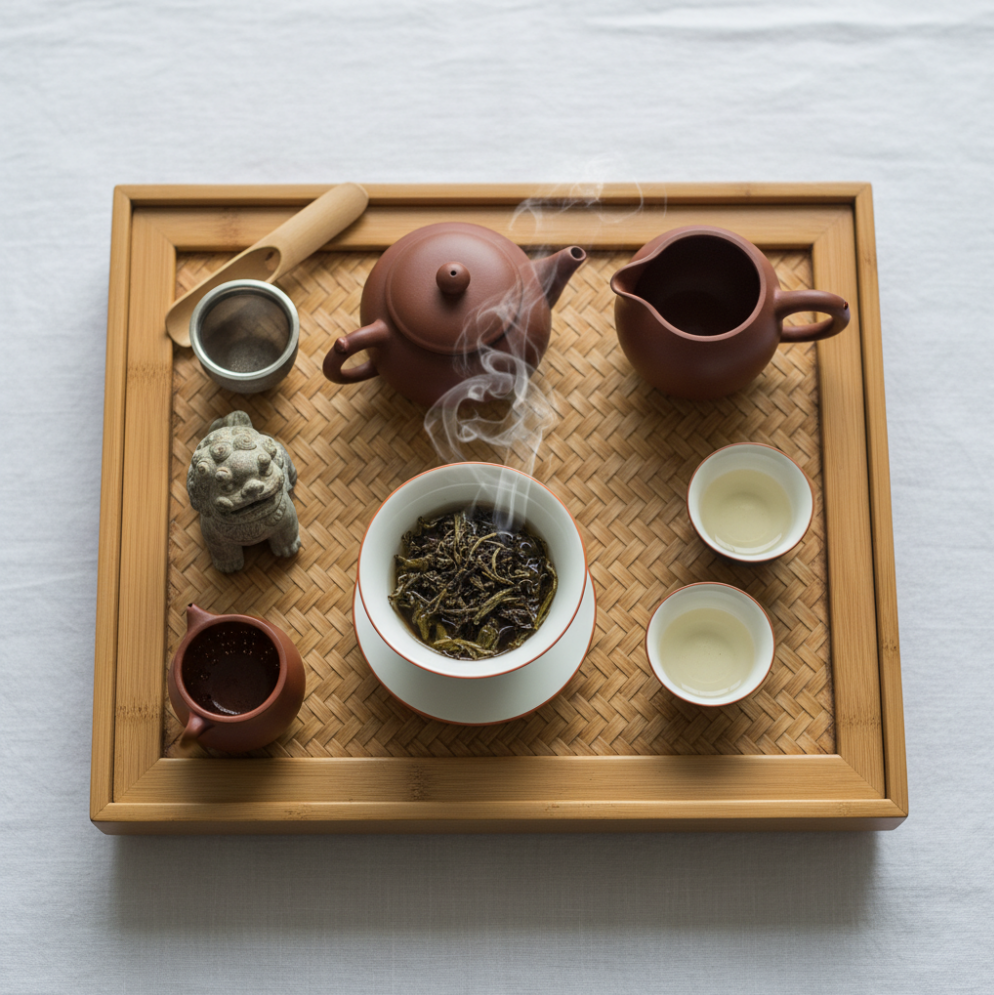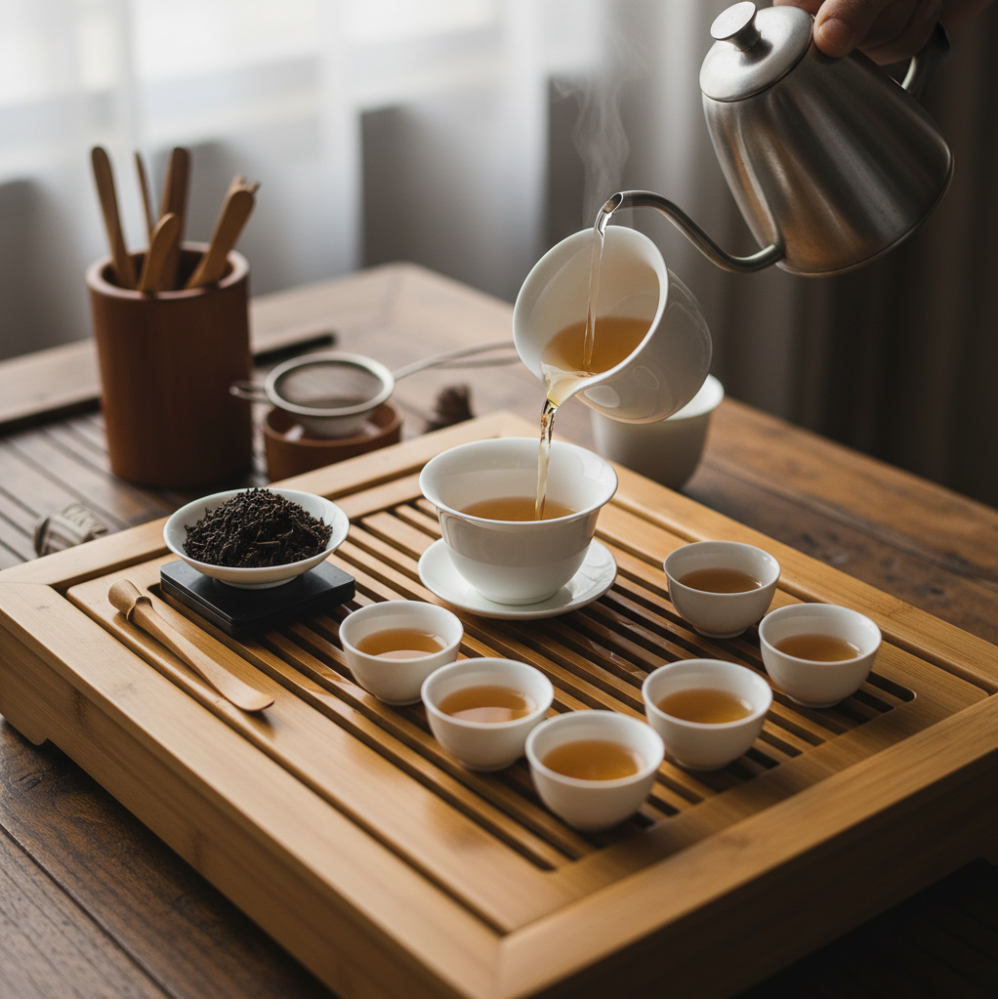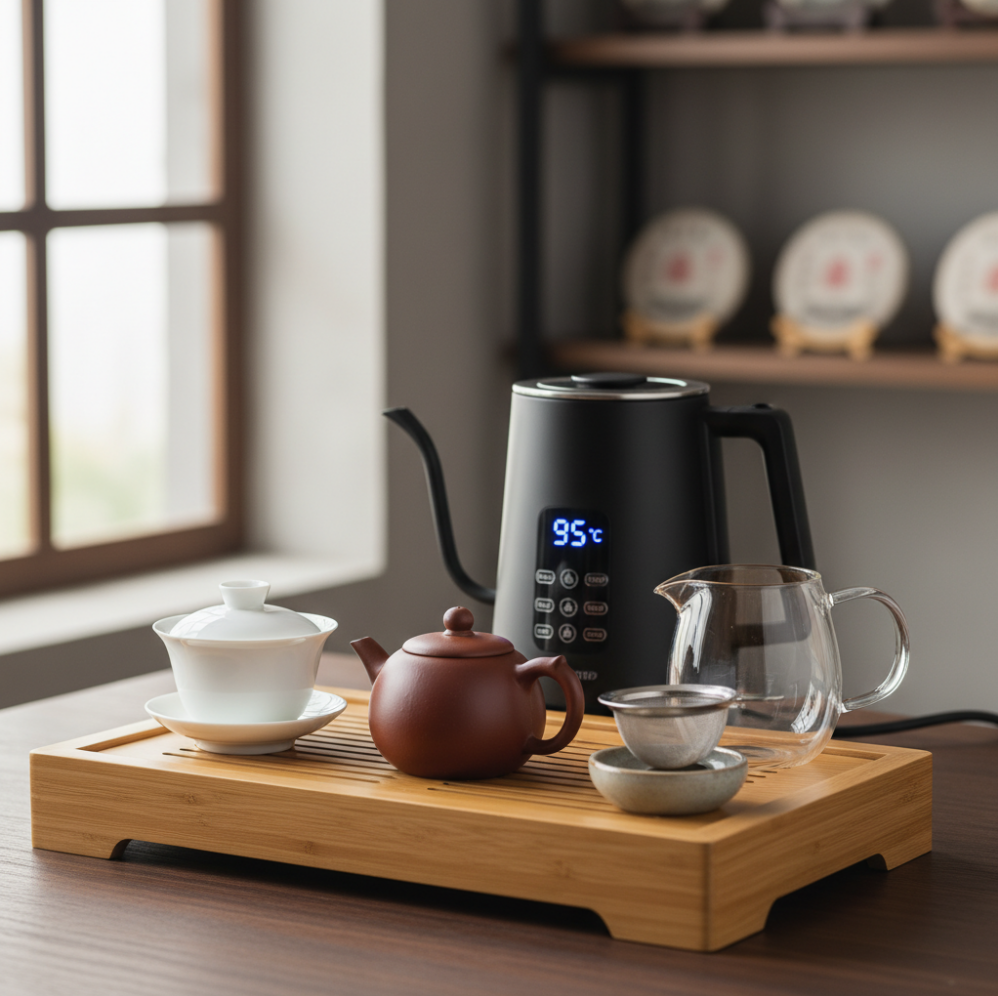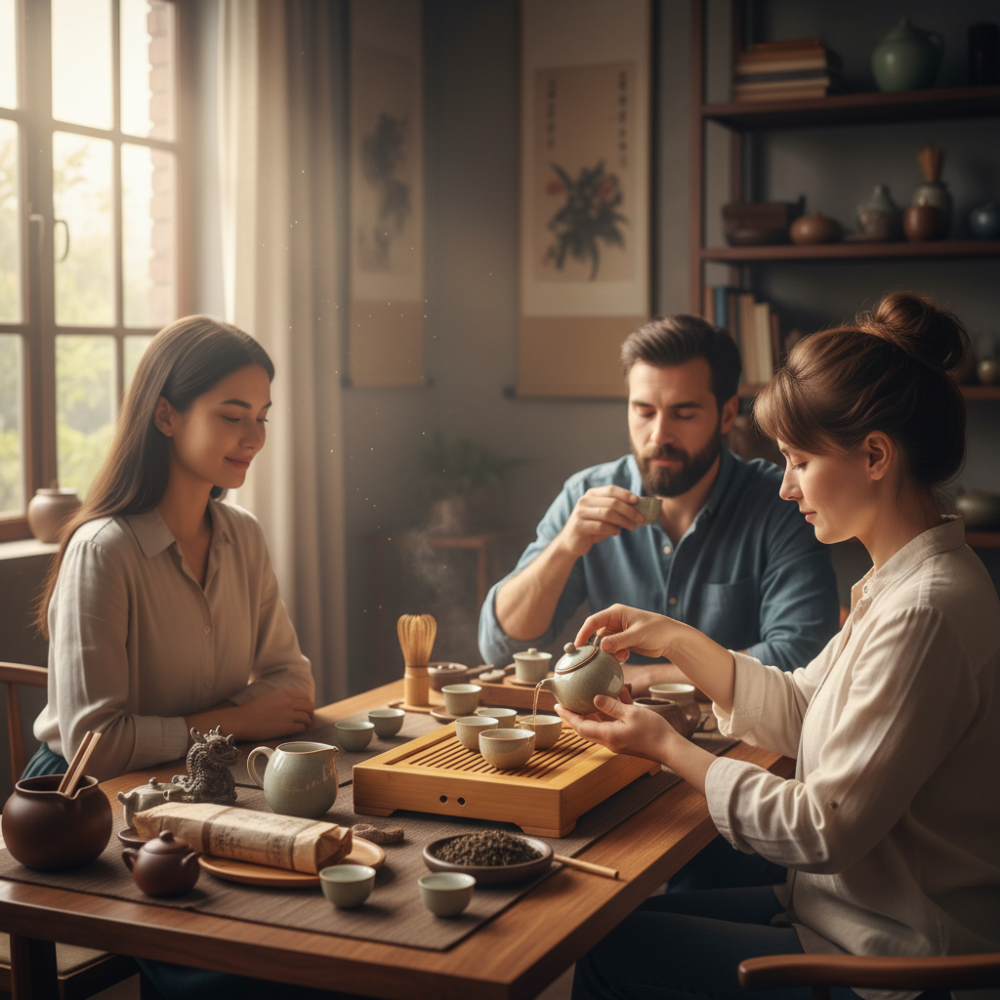Brewing Sheng Pu’er (also called raw Pu’er) in the Gongfu style is a bit like learning a living tradition that connects you with the roots of Yunnan tea culture. Unlike casual western brewing, Gongfu brings out levels of aroma and depth in good Sheng that just don’t show up in grandpa-style mugs or western teapots. Sheng Pu’er’s unique leaf structure, wild energy, and steady transformation through the session all mean it calls for some dedicated technique. If you’re looking for the basics of Gongfu, I recommend checking out the Complete Guide to Gongfu Brewing; here, the focus stays entirely on the art of Sheng Pu’er brewed its own special way.

What Makes Sheng Pu’er Special to Brew Gongfu Style
Sheng Pu’er is a tea with its own stubborn personality. Made from sundried large leaf varieties, it starts out vibrant and grassy, and it can mellow out over ten or twenty years. This living transformation is a major reason Gongfu brewing fits Sheng so well; each session lets you experience not just the terroir, but also the snapshot of where the tea is in its aging adventure.
When I work with young Sheng (less than 5 years old), I get a lot of fresh, floral, or even punchy green flavors with a real amount of bitterness and astringency if I’m not careful. As the tea ages, bitterness calms down and sweet, camphor, or dried fruit vibes appear. Some semi aged Sheng even brings out wild herbal, honeyed notes or forest floor complexity. Slowing down with the Gongfu method gives you a way to watch this tea reveal itself over many steeps, letting it open up right there in real time. Good Sheng always gives a boost to patience and curiosity.
Gongfu style brewing also changes your relationship with the tea. It isn’t just about extracting flavor; it’s about connecting with the leaf’s whole story, from tree to cup. If you want more inspiration for teas that really shine using this approach, the Best Gongfu Brewing Teas guide is worth checking out for ideas.
Choosing the Right Brewing Equipment for Sheng Pu’er

Picking the right gear can seriously change your Sheng sessions. Three vessel styles usually see the most use:
- Porcelain gaiwan: Clean, neutral, quick to heat and cool. I use this for sampling new teas or any Sheng that I want to taste as cleanly as possible.
- High fired or unglazed clay teapots (like zhuni or duanni Yixing): These pots make it easy to smooth out punchy young Sheng or give older tea a deeper mouthfeel. Clay can sometimes tone down bitterness and boost texture.
- Glass vessels: Rarely used for Sheng, but if you want to see the leaves dance visually, it’s a fun choice. There’s more in the Glass vs Clay Teapots for Gongfu guide on which vessel matches different teas.
For water, temperature control is key. That’s why a kettle that lets you set the temperature to the degree is so helpful—it doesn’t have to be fancy, just reliable. If you’re looking to upgrade your setup, Best Tea Kettles for Gongfu Brewing and the Smart Kettle Guide both have super detailed breakdowns. Don’t overlook the little accessories either; things like a good chahai (pitcher), strainer, or even aroma cups as described in the Best Gongfu Tea Accessories can make sessions much smoother and more fun.
Ideal Leaf Ratio for Sheng Pu’er
Getting the leaf to water ratio dialed in can make or break a Gongfu Sheng Pu’er session. The usual starting spot for me is about 5 to 7 grams of dry leaf per 100 ml of water. If you’re using an average 120 ml gaiwan or teapot, that’s about 7 to 8 grams. These are flexible guidelines, though:
- If you’re working with loose leaf, stick to the lower end (5 g/100 ml for young, bud heavy teas that can get bitter in a hurry).
- For broken up compressed cakes or bricks, use the middle of the range (6-7 g/100 ml).
- With tiny leaf, heavily compressed tuo cha, you might bump up toward 7-8 grams; just watch for dust, which can steep out too quickly.
When breaking apart cake or brick Sheng, be gentle; try to keep leaves as whole as you can, since dust and fragments can dump bitterness into your first few brews. Sifting out dust or clearing loose crumbs before brewing goes a long way to smoothing out the session. If your leaf is especially young and green, dropping the ratio to 4-5g/100ml and lengthening your steeps ever so slightly creates a softer, friendlier cup.
Water Temperature Guidelines
Water temp for Sheng Pu’er is a balancing act between pulling out aromatics without frying the leaves. Generally, I start young Sheng at around 90-92°C (194-198°F); this keeps bitterness in check and gives floral, green elements more room. For semi aged or older Sheng, I go up to 95-96°C (203-205°F) to unlock sweetness and depth.
If you notice too much bite, just lower the temp a couple of degrees to round off sharp flavors. But if a tea tastes flat or dull, don’t be afraid to raise it back up. Some teas open nicely with a gentle temp, then ask for hotter water as infusions go on and the leaves soften. Smart kettles with programmable memory help a lot here, especially if you want to play with temperature profiling mid-session.
Step by Step Gongfu Brewing Method for Sheng Pu’er

This is the heart of a good session; here’s the practical, step-by-step routine I use, blending the usual Gongfu approach with what real Sheng needs session by session.
- Warm your tea ware. Pour hot water through your teapot or gaiwan and cups. Swirling pre-warms them and helps the Sheng release more aroma right away. Dump out the rinse.
- Weigh out and add the leaves. Put your chosen gram weight (usually between 6–8 grams for a 120 ml vessel) in. Spread out compressed leaves gently.
- Rinse the leaves. Add just enough hot water (92–96°C / 198–205°F) to cover the leaves. Swirl for 5-10 seconds and pour it off. Some folks rinse twice for very compressed or dusty teas, but one rinse is usually enough for clean Sheng.
- First infusion. Start with a quick steep—10–15 seconds. Keep your senses open: look for pale gold or yellow green brew, inhale the steam, and give it a quick sip. Expect high floral notes, a touch of bitterness, and light minerality, especially with young Sheng.
- Increase steep times gradually. Each new round, bump steep time up by about 3–5 seconds. With most Sheng, you’ll get 10–12 infusions that start light and floral, then build more sweetness and body as the session goes.
- Mid session adjustment. As infusions progress (steeps 4–8), bitterness usually softens. Try hotter water (up to 96°C / 205°F) or longer steeps if the flavor starts fading.
- Last infusions. As the leaves tire (usually by steep 9 or beyond), you can push your steeps out to 30 seconds or more and bump water to near-boiling to extract every last bit of sweetness and aroma.
Sensory checkpoints to watch for:
- Early infusions: Intense, sometimes spicy or vegetal top notes. You might get bitterness or astringency; if it’s overwhelming, lower the temp a bit or shorten the next steep.
- Mid session (steeps 4–7): Sweeter, smoother body comes, and the aroma gets more layered (think stone fruit, dried grass, maybe wild honey or herbs). Mouthfeel often thickens and aftertaste sticks around longer.
- Late infusions: It’s all about subtlety—flavors mellow out, herbal sweet notes come forward, and you’ll likely get a real lingering hui gan (returning sweetness in the throat). Good Sheng finishes clean, uplifting, and bright even after a dozen rounds.
Common Mistakes to Avoid
- Over leafing: Too much leaf in too little water can crush you with bitterness and mouth drying astringency, especially with younger Sheng. When in doubt, use less and steep a bit longer.
- Using water that’s too hot for young Sheng: Starting at 96°C (205°F) or above on greenish teas can just roast delicate aromatics away and pull bitterness up front. Start a little lower and adjust later.
- Over rinsing or steeping aged Sheng too fast: Really old Pu’er can lose its aroma and flavor quickly if you rinse or flash steep it as aggressively as you do with young teas.
- Breaking up the cake into tiny bits or dust: Pulverized leaves brew out way too quickly, giving a murky cup and sharp taste. Take the time to peel off whole chunks wherever possible.
- Letting leaves sit between steeps: Don’t let the leaves dry out; try to finish your session in one go or keep the leaves warm if you take a break.
Every mistake is a learning experience, but these are all pretty easy to avoid once you’ve spotted them.
How Sheng Pu’er Evolves Through the Session
One of the most eye-catching things about Sheng Pu’er Gongfu sessions is just how much the tea transforms with each round.
- Early infusions (steeps 1–3): Expect clarity, sharp energy, high florals, and a strong sense of place (terroir), especially with young Sheng. Older Sheng may be more subtle but have woody, herbal, or camphor notes early.
- Middle infusions (4–7): Sweetness rises. Bitterness and astringency fade as the body gets thicker and more cooling. For Sheng with a few years of age, this is when qi (the tea’s feeling/energy) shines, and aftertaste grows.
- Late infusions (8+): The brew softens and smooths out. Sweet aftertaste (hui gan) lingers in your mouth and throat, with flavors that can be vegetal or almost syrupy with more aged examples. Young Sheng can become juicier at this stage; older Sheng will be soothing and clean.
Pay attention to body sensations and how returning sweetness switches up throughout the session. It’s a subtle experience you can’t get from single brew styles, making each session a new adventure with your favorite tea.
Recommended Teapots and Kettles for Sheng Pu’er

Finding the right teapot and kettle setup makes every session easier and more enjoyable. Here’s what I look for:
- Teapot size: Around 100-150 ml is ideal. Larger pots are fine for group sessions, but you want enough control to dial in your brews.
- Clay type: High fired Yixing or Chaozhou clay can tone down sharp notes. Porcelain or glazed ceramic is neutral; these are great if you want to taste the tea “as it is.”
- Pour speed: Fast pouring pots let you cut infusions at just the right moment, which is really useful for sensitive Sheng. Gaiwans shine for the same reason.
- Kettle: Go for something with precise temp control. If you’re stuck choosing, this brief on glass vs. clay helps out, and the Best Tea Kettles for Gongfu Brewing and Smart Kettle Guide break down what works best if you want perfectly tuned sessions every time.
I still use my porcelain gaiwan most often for Sheng, especially when tasting unfamiliar teas or sampling new cakes. Clay pots shine when I want texture and thickness in the cup.
Advanced Techniques and Variations
- Temperature profiling: Start with lower temps for early steepings (90–92°C / 194–198°F), then rise to 95–96°C (203–205°F) as tea opens. This brings out layers without flattening delicate tops.
- Flash steeping for young Sheng: Really bright or bitter teas get a short first infusion (as little as 5–7 seconds) to curb harshness, then slowly dial up timing.
- Longer infusions for aged Sheng: Don’t be afraid to push late session steeps to 40 seconds or even a full minute. The leaves have mellowed, so you’ll get more sweetness and thick mouthfeel without extra bitterness.
- Vessel swapping: Try steeping a session in both porcelain and clay; use the same leaf, different vessel, and see how the tea ware material changes the tea’s body and aroma.
- Double stacking: Brew two similar Shengs back-to-back and taste them side by side (comparing regions or years). It’s a fun way to sharpen your palate and spot subtle differences.
Experimenting with these advanced moves adds new layers of learning and enjoyment, especially as your confidence grows. These tweaks can help you set free even more flavor and character from each session.
Frequently Asked Questions
How do I know if my water is too hot for Sheng Pu’er?
If your tea tastes burnt, extra bitter, or loses its floral top notes right away, your water may be a bit hot, especially with young Sheng. Try dropping the temp by 2–3°C (3–5°F) to see if the tea smooths out.
Is Sheng Pu’er supposed to be bitter?
Bitter notes are common in young Sheng, but it shouldn’t be mouth drying or harsh. Bitterness should switch to sweetness in the aftertaste (hui gan). If it lingers or stings, ease up on the leaf amount or lower your brewing temperature.
How do I adjust for very young (or very old) Sheng Pu’er?
For young, bright green or newly pressed Sheng, use less leaf, cooler water (90–92°C / 194–198°F), and shorter steeps. For older Sheng, use hotter water (95–96°C / 203–205°F) and longer infusions to bring out aroma and sweetness.
Why does Sheng taste better after a few steeps?
Sheng Pu’er leaves take a few infusions to fully open, so early cups may be sharp, cloudy, or flat. Middle steeps reveal layered flavor and a cleaner, rounder body as the leaves hydrate.
Can beginners brew Sheng Gongfu style?
Absolutely. Sheng rewards patience and curiosity regardless of experience. Start slow, taste as you go, and keep notes. Every session is a learning experience.
Do I need a special teapot for Sheng Pu’er?
A porcelain gaiwan is versatile and perfect for Sheng, but clay teapots (especially high fired Yixing) tone down rough edges and add body if you want a softer, rounder cup.
How long does a Gongfu session with Sheng usually last?
With the right leaf ratio and timing, a full session can take 30–60 minutes and deliver a dozen or more steeps. Pacing yourself means you’ll get the full arc of flavor and aftertaste.
Is it okay to pause a session and come back later?
It’s best to finish the session in one sitting, but you can come back within a few hours as long as you keep the leaves covered and warm. Beyond that, flavors can get muddy or stale.
Final Thoughts

Brewing Sheng Pu’er Gongfu style is the kind of tea tradition that rewards curiosity, a little patience, and a willingness to experiment. No two sessions are quite the same, and your own tastes will go through a journey along with your favorite teas. I always suggest checking back to the Complete Guide to Gongfu Brewing and exploring related Gongfu tea articles for new ideas and ways to take up a notch your own style. The best Sheng Pu’er sessions are the ones where you keep tasting, tweaking, and learning straight from the cup. Time to roll with Sheng and see what you can track down in your own brewing adventures.
If you enjoyed this Sheng Pu’er Gongfu guide and want to experience the deeper, creamier side of Pu’er, the next step is to explore Shu (ripe) Pu’er. For a complete, real-world walkthrough on gear, ratios, water temperature, and troubleshooting specifically for Shu, check out this companion guide: How To Brew Shu Pu’er Gongfu Tea (Complete Guide).

Chris is the founder of Zen Tea Tools and a passionate explorer of traditional and modern tea brewing. From Gongfu sessions to smart tea technology, he shares practical insights to help others find clarity, calm, and better tea.Learn more about Chris →
Leave a Reply